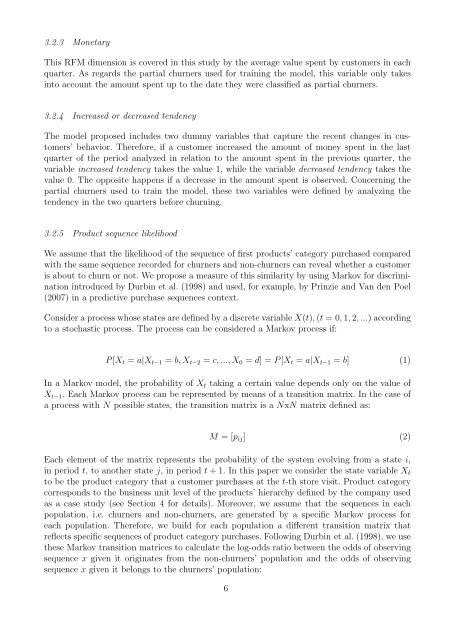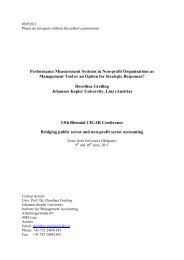Predicting Partial Customer Churn Using Markov for Discrimination ...
Predicting Partial Customer Churn Using Markov for Discrimination ...
Predicting Partial Customer Churn Using Markov for Discrimination ...
You also want an ePaper? Increase the reach of your titles
YUMPU automatically turns print PDFs into web optimized ePapers that Google loves.
3.2.3 Monetary<br />
This RFM dimension is covered in this study by the average value spent by customers in each<br />
quarter. As regards the partial churners used <strong>for</strong> training the model, this variable only takes<br />
into account the amount spent up to the date they were classified as partial churners.<br />
3.2.4 Increased or decreased tendency<br />
The model proposed includes two dummy variables that capture the recent changes in customers’<br />
behavior. There<strong>for</strong>e, if a customer increased the amount of money spent in the last<br />
quarter of the period analyzed in relation to the amount spent in the previous quarter, the<br />
variable increased tendency takes the value 1, while the variable decreased tendency takes the<br />
value 0. The opposite happens if a decrease in the amount spent is observed. Concerning the<br />
partial churners used to train the model, these two variables were defined by analyzing the<br />
tendency in the two quarters be<strong>for</strong>e churning.<br />
3.2.5 Product sequence likelihood<br />
We assume that the likelihood of the sequence of first products’ category purchased compared<br />
with the same sequence recorded <strong>for</strong> churners and non-churners can reveal whether a customer<br />
is about to churn or not. We propose a measure of this similarity by using <strong>Markov</strong> <strong>for</strong> discrimination<br />
introduced by Durbin et al. (1998) and used, <strong>for</strong> example, by Prinzie and Van den Poel<br />
(2007) in a predictive purchase sequences context.<br />
Consider a process whose states are defined by a discrete variable X(t), (t = 0, 1, 2, ...) according<br />
to a stochastic process. The process can be considered a <strong>Markov</strong> process if:<br />
P [Xt = a|Xt−1 = b, Xt−2 = c, ..., X0 = d] = P [Xt = a|Xt−1 = b] (1)<br />
In a <strong>Markov</strong> model, the probability of Xt taking a certain value depends only on the value of<br />
Xt−1. Each <strong>Markov</strong> process can be represented by means of a transition matrix. In the case of<br />
a process with N possible states, the transition matrix is a NxN matrix defined as:<br />
M = [pij] (2)<br />
Each element of the matrix represents the probability of the system evolving from a state i,<br />
in period t, to another state j, in period t + 1. In this paper we consider the state variable Xt<br />
to be the product category that a customer purchases at the t-th store visit. Product category<br />
corresponds to the business unit level of the products’ hierarchy defined by the company used<br />
as a case study (see Section 4 <strong>for</strong> details). Moreover, we assume that the sequences in each<br />
population, i.e. churners and non-churners, are generated by a specific <strong>Markov</strong> process <strong>for</strong><br />
each population. There<strong>for</strong>e, we build <strong>for</strong> each population a different transition matrix that<br />
reflects specific sequences of product category purchases. Following Durbin et al. (1998), we use<br />
these <strong>Markov</strong> transition matrices to calculate the log-odds ratio between the odds of observing<br />
sequence x given it originates from the non-churners’ population and the odds of observing<br />
sequence x given it belongs to the churners’ population:<br />
6
















